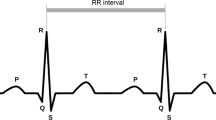Abstract
Stress and physical activities are important aspects of life of people. Body reactions on stress and on physical activities can be very similar but long-term stress leads to diseases and damages the body [1]. Currently there is no method to differentiate easily and clearly between these two aspects in a time slot. We have confronted this problem while developing a mobile system for detection and analysis of stress. This paper presents an approach, which uses a long-term monitor with ECG/EKG capabilities and analysis of the heart rate data that is extracted from the device. The focus of the work is to find characteristics that are useful for differentiation between physical activity and stress.
Preview
Unable to display preview. Download preview PDF.
Similar content being viewed by others
References
[1] B. S. McEWEN und T. SEEMAN, „Protective and Damaging Effects of Mediators of Stress,“ Annals of the New York Academy of Sciences, pp. 30-47, 06 02 2006.
[2] X. V. N. V. K. T. C. M. A. D. L. Arthur S. P. Jansen, „Central command neurons of the sympathetic nervous system: basis of the fight-or-flight response,“ in Science, Bd. Vol. 270, 1995, pp. 644-646.
[3] J. C. A. R. S. a. N. M. M. J. Martínez Fernández, „A Sensor Technology Survey for a Stress Aware Trading Process,“ IEEE Trans. On Systems, Man and Cybernetics Part C: Applications and reviews, Bd. 42, Nr. 6, pp. 809 - 824, 11 2012.
[4] J. Martínez Fernández, J. C. Augusto, R. Seepold und N. Martínez Madrid, Why Traders Need Ambient Intelligence, Germany: Springer Berlin Heidelberg, 2010.
[5] J. Martínez Fernández, J. C. Augusto, G. Trombino, R. Seepold und N. Martínez Madrid, „Self-Aware Trader: A New Approach to Safer Trading,“ in Journal of Universal Computer Science, 2013.
[6] B. Roozendaal, B. S. McEwen und S. Chattarji, „Stress, memory and the amygdala,“ Nature Reviews Neuroscience 10, pp. 423-433, 06 2009.
[7] S. J. Lupien, B. S. McEwen, M. R. gunnar und C. Heim, „Effects of stress throughout the lifespan on the brain, behaviour and cognition,“ Nature Reviews Neuroscience 10, pp. 434-445, 06 2009.
[8] K. Orth-Gomér, S. Wamala, M. Horsten, K. Schenck-Gustafsson, N. Schneiderman und M. Mittleman, „Marital stress worsens prognosis in women with coronary heart disease: The Stockholm Female Coronary Risk Study,“ in Journal of the American Medical Association, 2000.
[9] Y. Mei, M. D. Thompson, R. A. Cohen und X. Tong, „Autophagy and oxidative stress in cardiovascular diseases,“ in Biochimica et Biophysica Acta (BBA) - Molecular Basis of Disease, 2015.
[10] B. Gutin, P. Barbeau, S. Owens, C. R. Lemmon, M. Bauman, J. Allison, H.-S. Kang und M. Litaker, „Effects of exercise intensity on cardiovascular fitness, total body composition, and visceral adiposity of obese adolescents,“ American Society for Clinical Nutrition, Bd. 75, Nr. 5, pp. 818-826, May 2002.
[11] J. O. R. S. W.D. Scherz, „Towards emotion pattern extraction with the help of stress detection tech-niques in order to enable a healthy life,“ ARCA XXVII Conference on Qualitative Systems and Applications in Diagnosis, Robotics and Ambient Intelligence, 2016.
[12] J. O. N. M. M. R. S. W.D. Scherz, „Heart Rate Variability indicating Stress visualized by Correlations Plots,“ Lecture Notes in Bioinformatics and Biomedical Engineering (LNBI), Volume 9044, Subseries of Lecture Notes in Computer Science, 2015.
[13] T. Kidd, L. A. Carvalho und A. Steptoe, „The relationship between cortisol responses to laboratory stress andcortisol profiles in daily life,“ Biological Psychology, pp. 34-40, 25 02 2014.
[14] J. R. Stroop, „Studies of interference in serial verbal reactions,“ Journal of Experimental Psychology, pp. 643-662, 1935.
[15] C. Kirschbaum, K.-M. Pirke und D. H. Hellhammer, „The ‘Trier Social Stress Test’- A Tool for Investigating Pyschobiological Stress Responses in a Laboratory Settings,“ Neuropychobiologie, pp. 78-81, 1993.
[16] Y. Arai, J. P. Saul, L. H. Hartley, L. S. Lilly, R. J. Cohen und W. S. Colucci, „Modulation of cardiac autonomic activity during and immediately after exercise,“ American Journal of Physiology - Heart and Circulatory Physiology, pp. H132-H141, 01 1989.
[17] B. F. Robinson, S. E. Epstein, G. D. Beiser und E. Braunwald, „Control of heart rate by the autonomic nervous system: studies in man on the interrelation between baroreceptor mechanisms and exercise,“ Circulation Research, pp. 400-411, 4 04 1966.
Author information
Authors and Affiliations
Corresponding author
Editor information
Editors and Affiliations
Rights and permissions
Copyright information
© 2018 Springer Nature Singapore Pte Ltd.
About this paper
Cite this paper
Scherz, W.D., Ortega, J.A., Seepold, R., Conti, M. (2018). Pattern recognition techniques and classification sets supporting behavioural tagging when using a limited number of body sensors. In: Eskola, H., Väisänen, O., Viik, J., Hyttinen, J. (eds) EMBEC & NBC 2017. EMBEC NBC 2017 2017. IFMBE Proceedings, vol 65. Springer, Singapore. https://doi.org/10.1007/978-981-10-5122-7_231
Download citation
DOI: https://doi.org/10.1007/978-981-10-5122-7_231
Published:
Publisher Name: Springer, Singapore
Print ISBN: 978-981-10-5121-0
Online ISBN: 978-981-10-5122-7
eBook Packages: EngineeringEngineering (R0)




